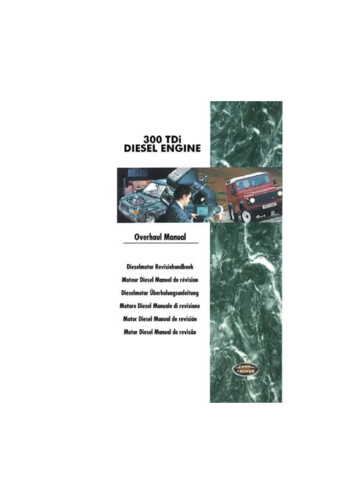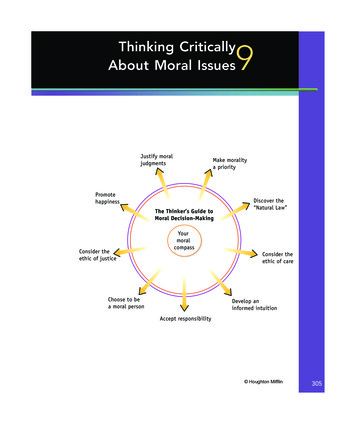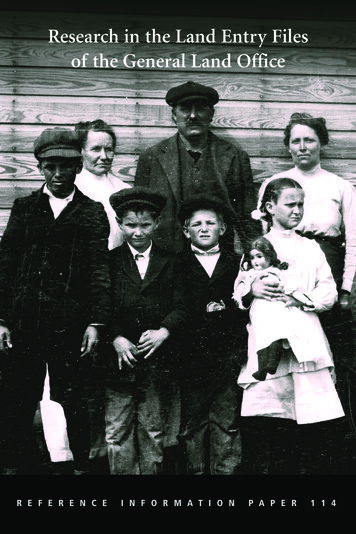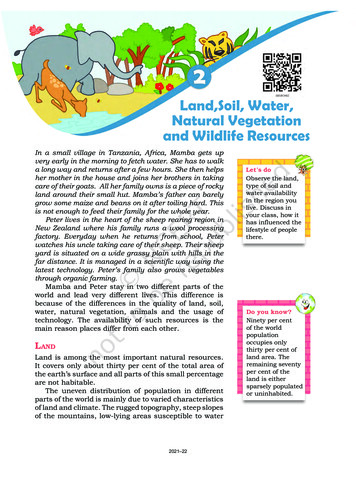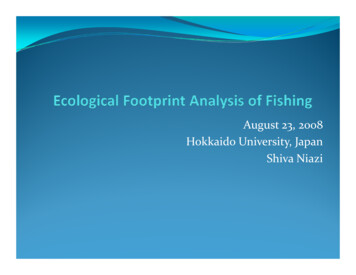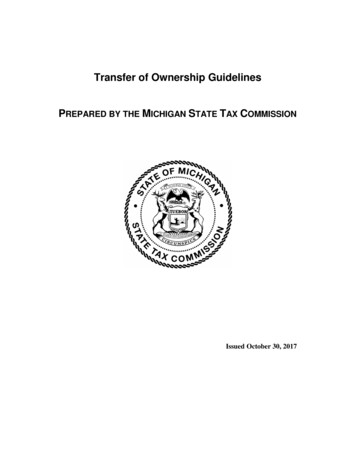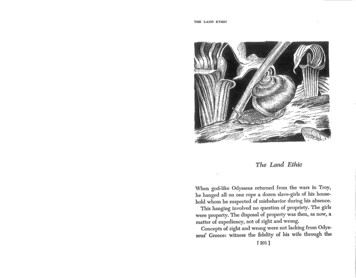
Transcription
THE UPSHOTan area usable either for recreation, or for science, or forwildlife, but the creation of new wilderness in the full senseof the word is impossible.It follows, then, that any wilderness program is a rearguard action, through which retreats are reduced to a minimum. The Wilderness Society was organized in 1935 'forthe one purpose of saving the wilderness remnants inAmerica.'It does not suffice, however, to have such a society. Unlessthere be wilderness-minded men scattered through all theconservation bureaus, the society may never learn of newinvasions until the time for action has passed. Furthermorea militant minority of wilderness-minded citizens must beon watch throughout the nation, and available for action ina pinch.In Europe, where wilderness has now reh·eated to theCarpathians and Siberia, every thinking conservationist bemoans its loss. Even in Britain, which has less room for landluxuries than almost any other civilized country, there is avigorous if belated movement for saving a few small spotsof semi-wild land.Ability to see the cultural value of wilderness boils down,in the last analysis, to a question of intellectual humility.The shallow-minded modern who has lost his rootage in theland assumes that he has already disGovered what is important; it is such who prate of empires, political or economic, that will last a thousand years. It is only the scholarwho appreciates that all history consists of successive excur, sions from a single starting-point, to which man returns againand again to organize yet another search for a durable scaleof values. It is only the scholar who understands why the[ 200]THE LAND ETHICraw wilderness gives definition and meaning to the humanenterprise.The Land EthicWhen god-like Odysseus returned from the wars in Troy,he hanged all on one rope a dozen slave-girls of his household whom he suspected of misbehavior during his absence.This hanging involved no question of propriety. The girlswere property. The disposal of property was then, as now, amatter of expediency, not of right and wrong.Concepts of right and wrong were not lacking from Odysseus' Greece: witness the fidelity of his wife through ther 2011
THE UPSHOTlong years before at last his black-prowed galleys clove thewine-dark seas for home. The ethical structure of that daycovered wives, but had not yet been extended to humanchattels. During the three thousand years which have sinceelapsed, ethical criteria have been extended to many fieldsof conduct, with corresponding shrinkages in those judgedby expediency only.The Ethical SequenceThis extension of ethics, so far studied only by philosophers,is actually a process in ecological evolution. Its sequencesmay be described in ecological as well as in philosophical,/ terms. An ethie, ecologically, is a lirqitation on freedom ofaction in the struggle for existence. An ethic, philosophically,is a differentiation of social from anti-social conduct. Theseare two definitions of one thing. The thing has its originin the tendency of interdependent individuals or groups toevolve modes of co-operation. The ecologist calls thesesymbioses. Politics and economics are advanced symbiosesin which the original free-for-all competition has been replaced, in part, by co-operative mechanisms with an ethicalcontent.The complexity of co-operative mechanisms has increasedwith population density, and with the efficiency of tools. Itwas simpler, for example, to define the anti-social uses ofsticks and stones in the days of the mastodons than of bulletsand billboards in the age of motors.The first ethics dealt with the relation between individuals; the Mosaic Decalogue is an example. Later accretions dealt with the relation between the individual andr. 202]THE LAND ETIDCsociety. The Golden Rule tries to integrate the individual tosociety; democracy to integrate social organization to theindividual.There is as yet no ethic dealing with man's relation toland and to the animals and plants which grow upon it.Land, like Odysseus' slave-girls, is still property. The landrelation is still strictly economic, entailing privileges but notobligations.The extension of ethics to this third element in humanenvironment is, if I read the evidence correctly, an evolu- /tionary possibility and an ecological necessity. It is the thirdstep in a sequence. The first two have already been taken.Individual thinkers since the days of Ezekiel and Isaiahhave asserted that the despoliation of land is not only inexpedient but wrong. Society, however, has not yet affirmedtheir belief. I regard the present conservation movement asthe embryo of such an affirmation.An ethic may be regarded as a mode of guidance for meeting ecological situations so new or intricate, or involvingsuch defened reactions, that the path of social expediencyis not discernible to the average individual. Animal instinctsare modes of guidance for the individual in meeting suchsituations. Ethics are possibly a kind of community instinctin-the-making.The Community ConceptAll ethics so far evolved rest upon a single premise: thatthe individual is a member of a community of interdependent parts. His instincts prompt him to compete for hisplace in that community, but his ethics prompt him also to[ 203]
THE UPSHOT/THE LAND ETHICco-operate (perhaps in order that there may be a place tocompete for).The land ethic simply enlarges the boundaries of thecommunity to include soils, waters, plants, and animals; orcollectively: the land.This sounds simple: do we not already sing our love forand obligation to the land of the free and the home of thebrave? Yes, but just what and whom do we love? Certainlynot the soil, which we are sending helter-skelter downriver.Certainly not the waters, which we assume have no functionexcept to turn turbines, float barges, and carry off sewage.Certainly not the plants, of which we exterminate wholecommunities without batting an eye. Certainly not theanimals, of which we have already extirpated many of thelargest and most beautiful species. A land ethic of coursecannot prevent the alteration, management, and use of these'resources,' but it does affirm their right to continued existence, and, at least in spots, their continued existence in anatural state.In short, a land ethic changes the role of Homo sapiensfrom conqueror of the land-community to plain memberand citizen of it. It implies respect for his fellow-members,and also respect for the community as such.In human history, we have learned (I hope) that theconqueror role is eventually self-defeating. Why? Becauseit is implicit in such a role that the conqueror knows, excathedra, just what makes the community clock tick, andjust what and who is valuable, and what and who is worthless, in community life. It always turns out that he knowsneither, and this is why his conquests eventually defeatthemselves.In the biotic community, a parallel situation exists. Abra-ham knew exactly what the land was for: it was to dripmilk and honey into Abraham's mouth. At the present moment, the assurance with which we regard this assumptionis inverse to the degree of our education.The ordinary citizen today assumes that science knowswhat makes the community clock tick; the scientist isequally sure that he does not. He knows that the bioticmechanism is so complex that its workings may never befully understood.That man is, in fact, only a member of a biotic team isshown by an ecological interpretation of history. Many historical events, hitherto explained solely in terms of humanenterprise, were actually biotic interactions between peopleand land. The characteristics of the land determined thefacts quite as potently as the characteristics of the menwho lived on it.Consider, for example, the settlement of the Mississippivalley. In the years following the Revolution, three groupswere contending for its control: the native Indian, theFrench and English traders, and the American settlers. Historians wonder what would have happened if the Englishat Detroit had thrown a little more weight into the Indianside of those tipsy scales which decided the outcome of thecolonial migration into the cane-lands of Kentucky. It is timenow to ponder the fact that the cane-lands, when subjectedto the particular mixture of forces represented by the cow,plow, fire, and axe of the pioneer, became bluegrass. Whatif the plant succession inherent in this dark and bloodyground had, under the impact of these forces, given us someworthless sedge, shrub, or weed? Would Boone and Kentonhave held out? Would there have been any overflow intoOhio, Indiana, Illinois, and Missouri? Any Louisiana Pur-[ 204][ 205 J
THE UPSHOTchase? Any transcontinental union of new states? Any Civil\Var?.Kentucky was one sentence in the drama of history. \Veare commonly told what the human actors in this dramatried to do, but we are seldom told that their success or the'lack of it, hung in large degree on the reaction of particularsoils to the impact of the particular forces exerted by theiroccupancy. In the case of Kentucky, we do not even knowwhere the bluegrass came from-whether it is a nativespecies, or a stowaway from Europe.Contrast the cane-lands with what hindsight tells usabout the Southwest, where the pioneers were equally brave,resourceful, and persevering. The impact of occupancy herebrought no bluegrass, or other plant fitted to withstandthe bumps and buffetings of hard use. This region, whengrazed by livestock, reverted through a series of more andmore worthless grasses, shrubs, and weeds to a condition ofunstable equilibrium. Each recession of plant types brederosion; each increment to erosion bred a further recessionof plants. The result today is a progressive and mutualdeterioration, not only of plants and soils, but of the animalcommunity subsisting thereon. The early settlers did notexpect this: on the cienegas of New Mexico some even cutditches to hasten it. So subtle has been its progress that fewresidents of the region are aware of it. It is quite invisible tothe tourist who finds this wrecked landscape colorful andcharming (as indeed it is, but it bears scant resemblance towhat it was in 1848).This same landscape was ·developed' once before, butwith quite different results. The Pueblo Indians settled theSouthwest in pre-Columbian times, but they happened not[ 206 JTHE LAND ETIIlCto be equipped with range livestock. Their civilization ex,pired, but not because their land expired.In India, regions devoid of any sod-forming grass havebeen settled, apparently without wrecking the land, by thesimple expedient of carrying the grass to the cow, ratherthan vice versa. ( \V' as this the result of some deep wisdom,or was it just good luck? I do not know.)In short, the plant succession steered the course of his- /tory; the pioneer simply demonstrated, for good or ill, whatsuccessions inhered in the land. Is history taught in thisspirit? It will be, once the concept of land as a communityreally penetrates our intellectual life.The Ecological ConscienceConservation is a state of harmony between men and land.'"Despite nearly a centmy of propaganda, conservation stillproceeds at a snail's pace; progress still consists largely ofletterhead pieties and convention oratory. On the back fortywe still slip two steps backward for each forward stride.The usual answer to this dilemma is more conservationeducation.' No one will debate this, but is it certain that onlythe volume of education needs stepping up? Is somethinglacking in the content as well?It is difficult to give a fair summa1y of its content in briefform, but, as I understand it, the content is substantiallythis: obey the law, vote right, join some organizations, andpractice what conservation is profitable on your own land;the government will do the rest.Is not this formula too easy to accomplish anythingworth-while? It defines no right or wrong, assigns no obliga[ 207]
THE UPSHOTTHE LAND ETHICtion, calls for no sacrifice, implies no change in the currentphilosophy of values. In respect of land-use, it urges onlyenlightened self-interest. Just how far will such educationtake us? An example will perhaps yield a partial answet.By 1930 it had become clear to all except the ecologicallyblind that southwestern Wisconsin's topsoil was slippingseaward. In 1933 the farmers were told that if they wouldadopt certain remedial practices for five years, the publicwould donate CCC labor to install them, plus the necessary machinery and materials. The offer was widely accepted, but the practices were widely forgotten when thefive-year contract period was up. The farmers continuedonly those practices that yielded an immediate and visibleeconomic gain for themselves.This led to the idea that maybe farmers would learn morequickly if they themselves wrote the rules. Accordingly theWisconsin Legislature in 1937 passed the Soil ConservationDistrict Law. This said to farmers, in effect: We, the public, will furnish you free technical service and loan youspecialized machinery, if you will write you1' own rules f01'land-use. Each county may write its own rules, and thesewill have the force of law. Nearly all the counties promptlyorganized to accept the proffered help, but after a decade ofoperation, no county has yet written a single rule. Therehas been visible progress in such practices as strip-cropping, pasture renovation, and soil liming, but none in fencing woodlots against grazing, and none in excluding plowand cow from steep slopes. The farmers, in short, haveselected those remedial practices which were profitable anyhow, and ignored those which were profitable to the community, but not clearly profitable to themselves.When one asks why no rules have been written, one istold that the community is not yet ready to support them;education must precede rules. But the education actually inprogress makes no mention of obligations to land over andabove those dictated by self-interest. The net result is thatwe have more education but less soil, fewer healthy woods,and as many floods as in 1937.The puzzling aspect of such situations is that the existenceof obligations over and above self-interest is taken forgranted in such rnral community enterprises as the betterment of roads, schools, churches, and baseball teams. Theirexistence is not taken for granted, nor as yet seriously discussed, in bettering the behavior of the water that falls onthe land, or in the preserving of the beauty or diversity ofthe fann landscape. Land-use ethics are still governedwholly by economic self-interest, just as social ethics were acentury ago.To sum up: we asked the farmer to do what he conveniently could to save his soil, and he has done just that,and only that. The farmer who clears the woods off a 75 percent slope, turns his cows into the clearing, and dumps itsrainfall, rocks, and soil into the community creek, is still (ifotherwise decent) a respected member of society. If he putslime on his fields and plants his crops on contour, he is stillentitled to all the privileges and emoluments of his SoilConservation District. The District is a beautiful piece ofsocial machinery, but it is coughing along on two cylindersbecause we have been too timid, and too anxious for quicksuccess, to tell the farmer the true magnitude of his obligations. Obligations have no meaning without conscience, andthe problem we face is the extension of the social consciencefrom people to land.No important change in ethics was ever accomplished[ 208][ 209]
THE UPSHOTwithout an internal change in our intellectual emphasis,loyalties, affections, and convictions. The proof that conservation has not yet touched these foundations of conduct/ lies in the fact that philosophy and religion have not yetheard of it. In our attempt to make conservation easy, wehave made it trivial.THE LAND ETIIlCno land ethic yet, but we have at least drawn nearer thepoint of admitting that birds should continue as a matter ofbiotic right, regardless of the presence or absence of economic advantage to us.Substitutes for a Land EthicWhen the logic of history hungers for bread and we handout a stone, we are at pains to explain how much the stoneresembles bread. I now describe some of the stones whichserve in lieu of a land ethic.One basic weakness in a conservation system based whollyon economic motives is that most members of the land community have no economic value. Wildflowers and songbirdsare examples. Of the 22,000 higher plants and animals nativeto Wisconsin, it is doubtful whether more than 5 per centcan be sold, fed, eaten, or otherwise put to economic use.Yet these creatures are members of the biotic community,and if (as I believe) its stability depends on its integrity,they are entitled 1o continuance.When one of these non-economic categories is threatened,and if we happen to love it, we invent subteifuges to give iteconomic importance. At the beginning of the century songbirds were supposed to be disappearing. Ornithologistsjumped to the rescue with some distinctly shaky evidence tothe effect that insects would eat us up if birds failed to control them. The evidence had to be economic in order to bevalid.It is painful to read these circumlocutions today. We haver210 iA parallel situation exists in respect of predatory mammals, raptorial birds, and fish-eating birds. Time was whenbiologists somewhat overworked the evidence that thesecreatures preserve the health of game by killing weaklings,or that they control rodents for the farmer, or that tlrny preyonly on 'worthless' species. Here again, the evidence had tobe economic in order to be valid. It is only in recent yearsthat we hear the more honest argument that predators aremembers of the community, and that no special interest hasthe right to exterminate them for the sake of a benefit, real[ 211]
THE UPSHOTor fancied, to itself. Unfortunately this enlightened view isstill in the talk stage. In the eld the extermination ofpredators goes merrily on: witness the impending erasureof the timber wolf by at of Congress, the ConservationBureaus, and many state legislatures.Some species of trees have been 'read out of the party'by economics-minded foresters because they grow tooslowly, or have too low a sale value to pay as timber crops:white cedar, tamarack, cypress, beech, and hemlock areexamples. In Europe, where forestry is ecologically moreadvanced, the non-commercial tree species are recognizedas members of the native forest community, to be preservedas such, within reason. Moreover some (like beech) havebeen found to have a valuable function in building up soilfertility. The interdependence of the forest and its constituent tree species, ground flora, and fauna is taken for granted.Lack of economic value is sometimes a character not onlyof species or groups, but of entire biotic communities:marshes, bogs, dunes, and 'deserts' are examples. Our formula in such cases is to relegate their conservation to government as refuges, monuments, or parks. The difficulty isthat these communities are usually interspersed with morevaluable private lands; the government cannot possibly ownor control such scattered parcels. The net effect is that wehave relegated some of them to ultimate extinction overlarge areas. If the private owner were ecologically minded,he would be proud to be the custodian of a reasonable proportion of such areas, which add diversity and beauty to hisfarm and .to his community.In some instances, the assumed lack of pro t in these'waste' areas has proved to be wrong, but only after most[ 212]THE LAND ETillCof them had been done away with. The present scramble toreflood muskrat marshes is a case in point.There is a clear tendency in American conservation torelegate to government all necessa1y jobs that private landowners fail to perform. Government ownership, operation,subsidy, or regulation is now widely prevalent in forestry,range management, soil and watershed management, parkand wilderness conservation, sheries management, andmigratory bird management, with more to come. Most ofthis growth in governmental conservation is proper andlogical, some of it is inevitable. That I imply no disapprovalof it is implicit in the fact that I have spent most of my lifeworking for it. Nevertheless the question arises: What is theultimate magnitude of the enterprise? Will the tax basecany its eventual rami cations? At what point will governmental conservation, like the mastodon, become handicapped by its own dimensions? The answer, if there is any,seems to be in a land ethic, or some other force which as- /signs more obligation to the private landowner.Industrial landowners and users, especially lumbermenand stockmen, are inclined to wail long and loudly aboutthe extension of government ownership and regulation toland, but (with notable exceptions) they show little disposition to develop the only visible alternative: the voluntary practice of conservation on their own lands.When the private landowner is asked to perform someunprofltable act for the good of the community, he todayassents only with outstretched palm. If the act costs himcash this is fair and proper, but when it costs only forethought, open-mindedness, or time, the issue is at least debatable. The overwhelming growth of land-use subsidies inrecent years must be ascribed, in large part, to the govern[ 213]
THE UPSHOTment's own agencies for conservation education: the landbureaus, the agricultural colleges, and the extension s.ervices.As far as I can detect, no ethical obligation toward land istaught in these institutions.To sum up: a system of conservation based solely on economic self-interest is hopelessly lopsided. It tends to ignore,and thus eventually to eliminate, many elements in the landcommunity that lack commercial value, but that are (as faras we know) essential to its healthy functioning. It assumes, falsely, I think, that the economic parts of the bioticclock will function without the uneconomic parts. It tendsto relegate to government many functions eventually toolarge, too complex, or too widely dispersed to be performedby government.An ethical obligation on the part of the private owner isthe only visible remedy for these situations.The Land PyramidAn ethic to supplement and guide the economic relationto land presupposes the existence of some mental image ofland as a biotic mechanism. We can be ethical only in relation to something we can see, feel, understand, love, orotherwise have faith in.The image commonly employed in conservation education is 'the balance of nature.' For reasons too lengthy todetail here, this gure of speech fails to describe accuratelywhat little we know about the land mechanism. A muchtruer image is the one employed in ecology: the biotic pyramid. I shall rst sketch the pyramid as a symbol of land, andlater develop some of its implications in terms of land-use.[ 214]THE LAND ETHICPlants absorb energy from the sun. This energy flowsthrough a circuit called the biota, which may be representedby a pyramid consisting of layers. The bottom layer is thesoil. A plant layer rests on the soil, an insect layer on theplants, a bird and rodent layer on the insects, and so on upthrough various animal groups to the apex layer, whichconsists of the larger carnivores.The species of a layer are alike not in where they camefrom, or in what they look like, but rather in what they eat.Each successive layer depends on those below it for foodand often for other services, and each in turn furnishes foodand services to those above. Proceeding upward, each successive layer decreases in numerical abundance. Thus, forevery carnivore there are hundreds of his prey, thousandsof their prey, millions of insects, uncountable plants. Thepyramidal form of the system reflects this numerical progression from apex to base. Man shares an intermediate layerwith the bears, raccoons, and squirrels which eat both meatand vegetables.The lines of dependency for food and other services arecalled food chains. Thus soil-oak-deer-Indian is a chainthat has now been largely converted to soil-corn-cow-farmer.Each species, including ourselves, is a link in many chains.The deer eats a hundred plants other than oak, and the cowa hundred plants other than corn. Both, then, are links ina hundred chains. The pyramid is a tangle of chains so /complex as to seem disorderly, yet the stability of the systemproves it to be a highly organized structure. Its functioningdepends on the co-operation and competition of its diverseparts.In the beginning, the pyramid of life was low and squat;the food chains short and simple. Evolution has added layer[ 215]
THE UPSHOTafter layer, link after link. Man is one of thousands of accre·tions to the height and complexity of the pyramid . Sciencehas given us many doubts, but it has given us at least onecertainty: the trend of evolution is to elaborate and divetsifythe biota.(.Land, then, is not merely soil; it is a fountain of en l'gy:flowing tlu:ough a circuit of soils, plants, and animals. Foodchains are the living channels which conduct energy upward; death and decay return it to the soil. The circuit is notclosed; some energy is dissipated in decay, some is added byabsorption from the air, some is stored in soils, peats, andlong-lived forests; but it is a sustained circuit, like a slowlyaugmented revolving fund of life. There is always a net lossby downhill wash, but this is normally small and offset bythe decay of rocks. It is deposited in the ocean and, in thecourse of geological time, raised to f01m new lands and newpyramids.The velocity and character of the upward flow of energydepend on the complex structure of the plant and animalcommunity, much as the upward :How of sap in a tree depends on its complex cellular organization. Without thiscomplexity, normal circulation would presumably not occur.Structure means the characteristic numbers, as well as thecharacteristic kinds and functions, of the component species.This interdependence between the complex structure of theland and its smooth functioning as an energy unit is oneof its basic attributes.When a change occurs in one part of the circuit, manyother parts must adjust themselves to it. Change does notnecessarily obsh·uct or divert the flow of energy; evolutionis a long series of self-induced changes, the net result ofwhich has been to elaborate the :How mechanism and to[ 216]THE LAND ETHIClengthen the circuit. Evolutionary changes, however, areusually slow and local. Man's invention of tools has enabled /him to make changes of unprecedented violence, rapidity,and scope.One change is in the composition of floras and faunas.The larger predators are lopped off the apex of the pyramid;food chains, for the first time in history, become shorterrather than longer. Domesticated species from other landsare substituted for wild ones, and wild ones are moved tonew habitats. In this world-wide pooling of faunas andfloras, some species get out of bounds as pests and diseases,others are extinguished. Such effects are seldom intended orforeseen; they represent unpredicted and often untraceablereadjushnents in the structure. Agricultural science is largelya race between the emergence of new pests and the emergence of new techniques for their control.Another change touches the How of energy through plantsand animals and its return to the soil. Fertility is the ability /of soil to receive, store, and release energy. Agriculture, byoverdrafts on the soil, or by too radical a substitution ofdomestic for native species in the supersh·ucture, may derange the channels of flow or deplete storage. Soils depletedof their storage, or of the organic matter which anchors it,wash away faster than they form. This is erosion.Waters, like soil, are part of the energy circuit. Industry,by polluting waters or obstmcting them with dams, mayexclude the plants and animals necessa1y to keep energyin circulation.Transportation brings about another basic change: theplants or animals grown in one region are now consumedand returned to the soil in another. Transportation taps the[ 217]
THE UPSHOTenergy stored in rocks, and in the air, and uses it elsewhere;thus we fertilize the garden with nitrogen gleaned. by theguano birds from the fishes of seas on the other side of theEquator. Thus the formerly localized and self-contained circuits are pooled on a world-wide scale.The process of altering the pyramid for human occupationreleases stored energy, and this often gives rise, during thepioneering period, to a deceptive exuberance of plant andanimal life, both wild and tame. These releases of bioticcapital tend to becloud or postpone the penalties of violence.This thumbnail sketch of land as an energy circuit conveysthree basic ideas:( 1) That land is not merely soil.( 2) That the native plants and animals kept the energycircuit open; others may or may not.( 3) That man-made changes are of a different order thanevolutionary changes, and have effects more comprehensivethan is intended or foreseen.These ideas, collectively, raise two basic issues: Can theland adjust itself to the new order? Can the desired alterations be accomplished with less violence?Biotas seem to differ in their capacity to sustain violentconversion. Western Europe, for example, carries a far different pyramid than Caesar found there. Some large animalsare lost; swampy forests have become meadows or plowland; many new plants and animals are introduced, some ofwhich escape as pests; the remaining natives are greatlychanged in distribution and abundance. Yet the soil is stillthere and, with the help of imported nutrients, still fertile;the waters flow normally; the new structure seems to func[ 218]THE LAND ETHICtion and to persist. There is no visible stoppage or derange·ment of the circuit.Western Europe, then, has a resistant biota. Its inner processes are tough, elastic, resistant to strain. No matter howviolent the alteratio
environment is, if I read the evidence correctly, an evolu- / tionary possibility and an ecological necessity. It is the third step in a sequence. The first two have already been taken. Individual thinkers since the days of Ezekiel and Isaiah have asserted that the

